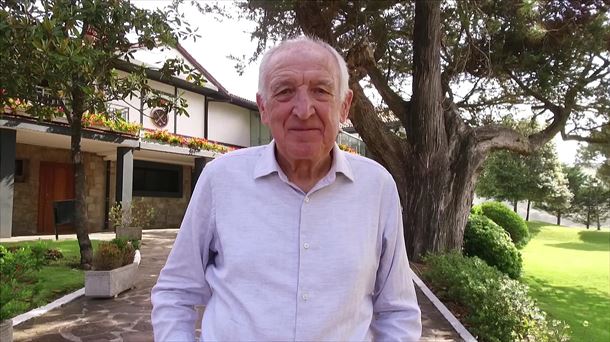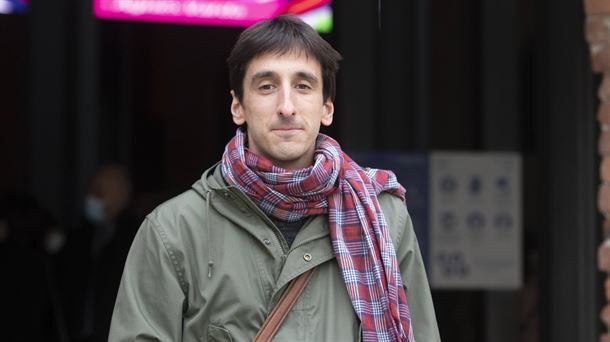“Anjel Lertxundi has never been satisfied with staying in a single space or literary option”
Euskaraz irakurri: “Anjel Lertxundi ez da inoiz konformatu eremu bakarrean edo aukera literary bakarrean geratuta”
It does not seem like a simple undertaking: it is about detailing the work of Anjel Lertxundi (Orio, 1948), in which scripts, film directing, journalism, articles, children’s and youth literature, stories and the novel have had a place for fifty years, in which some fundamental titles in the modern basque literature hamaseigarrenean, aidanez, Otto Pette, Zorion perfect and Azkenaz beste.
However, that is the objective of the seminar “Anjel Lertxundi: idazlea eta obra”framed in the UPV Summer Courses, for which its directors, Beatriz Zabalondo and Alex Gurrutxaga have designed a team of speakers to match such a large company.
The directors themselves and experts such as Lourdes Otaegi, Beñat Sarasola, Idoia Santamaría, Andoni Egaña, Iratxe Retolaza and Juan Kruz Igerabide will offer lectures on different aspects of Lertxundi’s literary endeavor such as the expression of gender violence in his texts, the thought , translation, the language itself, orality…

Anjel Lertxundi, in the ETB program ‘Artefatua’
Precisely, in the prelude to the beginning of the course, we have spoken with the professor and researcher Alex Gurrutxagawho has told us that, in addition to the academic presentations, there will be other activities (an interview between Anjel Lertxundi and the writer and journalist Danele Sarriugarte, a reading of texts set to music by Joxan Goikoetxea) and Lertxundi himself will end the course with a chat.
This is what Gurrutxaga has told us:
How do you compress a fifty-year-old work into a day and a half? What kind of dynamic have you designed and from what fields or theoretical frameworks will you look at the vast work of Lertxundi?
That is the biggest challenge of the course. Lertxundi’s work is enormous and has many ramifications. What’s more, I would say that this richness is one of the hallmarks of his work: he has worked in many fields of culture, and has also followed many paths within literature.
We quickly saw that to answer that, we had to bring many voices and perspectives into the course. We have extraordinary and extraordinary speakers, which is the most important thing, and each one will deal with Lertxundi’s work from his point of view: gender studies, cultural studies, the treatment of conflict, children’s literature, cinema, orality…
In addition, up to now no such deep approach has been made to the work of Lertxundi. We want to think that it is a beginning, and that we are going to offer a basis for future research.
In addition to directing the course together with Beatriz Zabalondo, you are going to offer the conference “Anjel Lertxundi, bilaketatik sorkuntzara”. What aspect of Lertxundi’s work have you developed?
I will address the field that experts call intertextuality. It is a very broad field, and it will be a modest approach, but I am very interested in what relationship Lertxundi has with other authors, with other books, with universal literature…
I believe that therein lies a way of understanding and practicing literature that is key to Lertxundi’s work. That is the origin, the reader or seeker who precedes or supports the writer. And from there, I would like to reflect on the ways in which Lertxundi integrates this extensive library into his work.
In your opinion, is there any thread that unites beyond the notable differences Hunik arrats arteanLertxundi’s first publication, and his latest books as they could be Gilles de Rais and desert behatxuloa? Which are?
I couldn’t tell you exactly. I perceive some things: concern for literary expression, for example, or reflection on the relationship between theme and form… But you have to investigate.
What is clear is that Lertxundi has never been satisfied with staying in a single space or literary option. This is the origin of the branch that I mentioned before.

Alex Gurrutxaga. Eusko Ikaskuntza photographic archive. Photographer: Jesús Mari Pemán.
The novels hamaseigarrenean, aidanez, Otto Pette, Zorion perfect, argizariaren egunak and Zu, the essays Eskarmentuaren paperak and desert behatxuloaa vast work of children’s and youth literature… What tour would you suggest to anyone who wanted to delve into the work of Anjel Lertxundi?
If you’ll pardon me, to begin with I would tell him to take a long-distance train, because it will take a long time.
I think that in that work there are, to begin with, books that are already classics: Otto Pette and hamaseigarrenean, aidanez, above all. It is also worth mentioning other more recent adult novels; it is remarkable Azkenaz bestemy favorite among many others.
I also find remarkable the series that moves between the essay and the novel: the novel Zuessay desert behatxuloa and many others. And with this we would have arrived more or less at the first stop, because we lack books dedicated to boys and girls, essays…
Lertxundi himself will participate in the course, interviewed by the journalist and writer Danele Sarriugarte and in a conference that will close the seminar. How have you taken this course and the recent tribute offered by the town of Zarautz?
I think you like it. The Zarautz thing was exciting, and everyone and all the participants were really great.
Anjel has already had the best prize for a long time, which is the affection and affection of the readers, but the academy also has to do its part (even if it is later), and I think they have taken it with satisfaction.
We have also given him a bit of homework, as you said, and, in addition to the interview, at the end he will speak. But researchers and researchers, readers and readers and he himself will be in the mood for celebration.
Source: Eitb
Bruce is a talented author and journalist with a passion for entertainment . He currently works as a writer at the 247 News Agency, where he has established himself as a respected voice in the industry.












